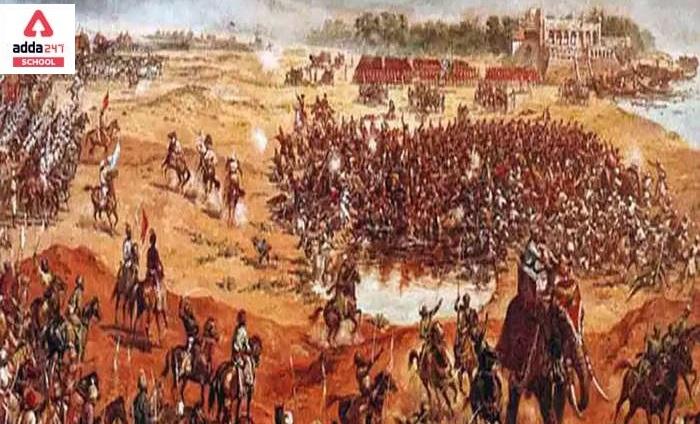Panipat is a historic city in the Indian state of Haryana, located 95 kilometres north of Delhi and 169 kilometres south of Chandigarh. The city is known as the “Textile City” and the “City of Weavers.” It’s sometimes referred to as the “cast-off capital.” Because it is “the global centre for recycling textiles,” it is regarded as the “cast-off capital.” Panipat is on the list of India’s Critically Polluted Industrial Areas. This city is a Rajputana city, and it is also recognised for three big battles that took place there in 1526, 1556, and 1761.
But why were these three major battles fought here itself? We will get to know about it as we read this article. Let’s start with the first battle of Panipat.
The First Battle of Panipat
Babur, a descendent of Timur, became a refugee when he was twelve years old. It was also about this time that the Uzbeks took control of Samarkand in 1494. Babur was back with his own Warband when he reached fifteen, and he lay siege to his home city, but the siege failed. Then he moved south into Afghanistan, seizing Kabul in 1504 and using it as a base for attacks into the Transoxania region of Central Asia. Furthermore, he was enticed by India’s inconceivable wealth, and he staged a series of raids into Punjab in the years that followed. These lands had formerly belonged to the Delhi Sultanate, which, despite its reputation being shattered by Timur’s victory in 1398, remained formidable in northern India. Sultan Ibrahim Lodi, a capricious and divided monarch who had alienated many of his nobility, ruled the sultanate at the time. In 1523, a local lord in Hindustan encouraged Babur to embark on a full-scale invasion, and while he was certainly enticed by the prospect of invasion, Babur was not in a rush. Babur’s army was only 10,000 men, so he made sure they were well-equipped and well-trained, which is why he took the effort to teach them how to utilise gunpowder weapons while also ensuring that their traditional steppe fighting abilities were not abandoned. He didn’t start his assault until the end of 1525.
On April 21, 1526, the Afghan Sultan of Delhi, Ibrahim Lodhi, and the Turko-Mongol commander Babur, who subsequently established Mughal power in the Northern Indian subcontinent, fought the First Battle of Panipat. At Panipat, a vastly outnumbered Mughal force triumphed. This was owing to Babur’s inventiveness, as seen by his deployment of field fortifications and innate understanding of the significance of gunpowder’s firepower. With the triumph, he was able to create the foundations for the Mughal Empire in India. Ibrahim’s far greater troop of almost one lakh warriors was defeated by Babur’s force. The ‘Lodi Rule’ founded in Delhi by Bahlul Lodhi came to an end with the first battle of Panipat., marking the beginning of Mughal power in India.
The First (1) Battle of Panipat fought between
Afghan Sultan, Ibrahim Lodhi, and the Turko-Mongol commander Babur, fought the First Battle of Panipat.
The Second Battle of Panipat
After Babur’s death in 1530, the Mughal Empire’s expansion came to a halt, but it resumed under his grandson. Humayun, Babur’s son, had suffered a series of defeats. He even lost his empire when Sher Shah Suri seized it in 1540. After fifteen years, he was able to reclaim his domains. After Humayun’s death, Akbar was left with a vast kingdom.
Hemu, a Hindu king who had previously served as a commander and Chief Minister under the Suri dynasty, had established himself as a strongman ruler to the east of Akbar’s territories. He had established a stronghold in Bengal.
On November 5, 1556, the forces of Akbar and Hem Chandra Vikramaditya battled in the Second Battle of Panipat. The setting was setup for the Second Battle of Panipat on November 5, 1556, with outnumbered Mughal warriors. Hemu, who was placed high up on an elephant, led from the front. For the Mughal archers, he was also an enticing target. His men were initially victorious, but one arrow penetrated the invincible head-to-foot armor’s eye-slit and killed him. Furthermore, after their leader was killed, his troops retreated.
Hemu was carried unconscious to Akbar’s camp, where he was decapitated by Bairam Khan; his head was sent to Kabul and put outside the Delhi Darwaza, while his torso was hanging outside Purana Quila in Delhi.
Panipat is also recorded as a pargana under Delhi sarkar in the Ain-i-Akbari.
Read About: Champaran Satyagraha Movement
The Second Battle of Panipat 2 fought between
The Army of Akbar and Army of Hem Chandra Vikramaditya (hemu) battled in the Second Battle of Panipat.
The Third Battle of Panipat
The Maratha Confederacy had grown fast following the fall of the Mughal Empire. It posed a challenge to Ahmad Shah Durrani’s Afghan Durrani Empire. The Marathas responded by recruiting a huge army under the command of Sadashivrao Bhau and recapturing Delhi after Ahmad launched a campaign and took significant sections of Punjab. To starve the Maratha army of supplies, Ahmad Shah Durrani simultaneously sent a 40,000-strong army into the south to trap the Maratha army in Punjab. In addition, Bhau decided to break Ahmad’s blockade, causing the two armies to clash at Panipat.
After breaking the blockade, the former intended to smash the latter’s army with a heavy artillery bombardment and move south in a defensive posture. Rivalries within his ranks, however, weakened him. Before the cannons could inflict any damage, Bhau’s nephew was killed, and then Durrani launched a surprise attack. The Maratha commander entered the combat to reclaim his nephew’s body. His troops, on the other hand, believed he was dead, and their morale dropped, which was exploited by the smaller Durrani army, which routed them.
This battle acted as a forerunner for the East India Company to establish Company authority in India, as most of the North and Northwest Indian princely states were weakened.
The Third Battle of Panipat 3 fought between
The Maratha Confederacy was growing rapidly following the fall Mughal Empire. It was a major threat towards Ahmad Shah Durrani’s Afghan Durrani Empire. The Marathas responded by forming massive troops under the leadership of Sadashivrao Bau. They also reclaimed Delhi following Ahmad began a war and seized large sections of Punjab.
Battle of Panipat in Hindi
पानीपत की पहली लड़ाई: पानीपत की लड़ाई 1
तैमूर का वंशज बाबर बारह साल की उम्र में शरणार्थी बन गया था। यह इस समय के बारे में भी था कि 1494 में उजबेकों ने समरकंद पर अधिकार कर लिया था। पंद्रह वर्ष की आयु में बाबर अपने स्वयं के वारबैंड के साथ वापस आ गया था, और उसने अपने गृह शहर की घेराबंदी की, लेकिन घेराबंदी विफल रही। फिर वह दक्षिण में अफगानिस्तान चला गया, 1504 में काबुल पर कब्जा कर लिया और इसे मध्य एशिया के ट्रांसऑक्सानिया क्षेत्र में हमलों के लिए एक आधार के रूप में इस्तेमाल किया। इसके अलावा, वह भारत की अकल्पनीय संपत्ति से मोहित हो गया था, और उसने आने वाले वर्षों में पंजाब में कई छापे मारे। ये भूमि पूर्व में दिल्ली सल्तनत की थी, जो 1398 में तैमूर की जीत से अपनी प्रतिष्ठा को चकनाचूर करने के बावजूद उत्तरी भारत में दुर्जेय बनी रही। सुल्तान इब्राहिम लोदी, एक सनकी और विभाजित सम्राट, जिसने अपने कई कुलीनों को अलग-थलग कर दिया था, उस समय सल्तनत पर शासन किया था। 1523 में, हिंदुस्तान में एक स्थानीय स्वामी ने बाबर को पूर्ण पैमाने पर आक्रमण करने के लिए प्रोत्साहित किया, और जब वह निश्चित रूप से आक्रमण की संभावना से मोहित हो गया, तो बाबर जल्दी में नहीं था। बाबर की सेना में केवल 10,000 लोग थे, इसलिए उन्होंने सुनिश्चित किया कि वे अच्छी तरह से सुसज्जित और अच्छी तरह से प्रशिक्षित थे, यही वजह है कि उन्होंने उन्हें बारूद हथियारों का उपयोग करने का तरीका सिखाने का प्रयास किया, साथ ही यह भी सुनिश्चित किया कि उनकी पारंपरिक स्टेपी लड़ने की क्षमता को नहीं छोड़ा जाए। उसने 1525 के अंत तक अपना हमला शुरू नहीं किया।
21 अप्रैल, 1526 को, दिल्ली के अफगान सुल्तान, इब्राहिम लोधी और तुर्क-मंगोल कमांडर बाबर, जिन्होंने बाद में उत्तरी भारतीय उपमहाद्वीप में मुगल सत्ता की स्थापना की, ने पानीपत की पहली लड़ाई लड़ी। पानीपत में, एक बहुत अधिक संख्या में मुगल सेना की विजय हुई। यह बाबर की आविष्कारशीलता के कारण था, जैसा कि उसके द्वारा क्षेत्रीय किलेबंदी की तैनाती और बारूद की मारक क्षमता के महत्व की सहज समझ से देखा गया था। विजय के साथ, वह भारत में मुगल साम्राज्य की नींव बनाने में सक्षम था। लगभग एक लाख योद्धाओं की इब्राहिम की कहीं अधिक बड़ी सेना बाबर की सेना से हार गई थी। बहलुल लोधी द्वारा दिल्ली में स्थापित ‘लोदी शासन’ पानीपत की पहली लड़ाई के साथ समाप्त हो गया, जिससे भारत में मुगल सत्ता की शुरुआत हुई।
प्रथम (1) पानीपत का युद्ध किसके बीच लड़ा गया?
अफगान सुल्तान, इब्राहिम लोधी और तुर्क-मंगोल कमांडर बाबर ने पानीपत की पहली लड़ाई लड़ी।
पानीपत की दूसरी लड़ाई: पानीपत की लड़ाई 2
1530 में बाबर की मृत्यु के बाद, मुगल साम्राज्य का विस्तार रुक गया, लेकिन यह उसके पोते के अधीन फिर से शुरू हो गया। बाबर के बेटे हुमायूँ को कई हार का सामना करना पड़ा था। 1540 में जब शेर शाह सूरी ने इसे जब्त कर लिया तो उसने अपना साम्राज्य भी खो दिया। पंद्रह वर्षों के बाद, वह अपने डोमेन को पुनः प्राप्त करने में सक्षम था। हुमायूँ की मृत्यु के बाद, अकबर के पास एक विशाल राज्य रह गया था।
हेमू, एक हिंदू राजा, जिसने पहले सूरी वंश के तहत एक कमांडर और मुख्यमंत्री के रूप में कार्य किया था, ने खुद को अकबर के क्षेत्रों के पूर्व में एक मजबूत शासक के रूप में स्थापित किया था। उसने बंगाल में अपना गढ़ बना लिया था।
5 नवंबर, 1556 को, अकबर और हेम चंद्र विक्रमादित्य की सेना ने पानीपत की दूसरी लड़ाई में लड़ाई लड़ी। 5 नवंबर, 1556 को पानीपत की दूसरी लड़ाई के लिए सेटिंग स्थापित की गई थी, जिसमें मुगल योद्धाओं की संख्या अधिक थी। हेमू, जो एक हाथी पर ऊंचा रखा गया था, सामने से नेतृत्व कर रहा था। मुगल धनुर्धारियों के लिए, वह एक मोहक लक्ष्य भी था। उसके लोग शुरू में विजयी हुए थे, लेकिन एक तीर अजेय सिर-से-पैर के कवच की आंख के छेद में घुस गया और उसे मार डाला। इसके अलावा, उनके नेता के मारे जाने के बाद, उनके सैनिक पीछे हट गए।
हेमू को अकबर के शिविर में बेहोश कर दिया गया था, जहां बैरम खान ने उसका सिर काट दिया था; उसका सिर काबुल भेज दिया गया और दिल्ली दरवाजे के बाहर रख दिया गया, जबकि उसका धड़ दिल्ली में पुराना किला के बाहर लटका हुआ था।
आइन-ए-अकबरी में दिल्ली सरकार के तहत पानीपत को परगने के रूप में भी दर्ज किया गया है।
पानीपत 2 का दूसरा युद्ध किसके बीच लड़ा गया?
पानीपत की दूसरी लड़ाई में अकबर की सेना और हेम चंद्र विक्रमादित्य (हेमू) की सेना ने लड़ाई लड़ी।
पानीपत की तीसरी लड़ाई: पानीपत की लड़ाई 3
मुगल साम्राज्य के पतन के बाद मराठा संघ तेजी से विकसित हुआ था। इसने अहमद शाह दुर्रानी के अफगान दुर्रानी साम्राज्य के लिए एक चुनौती पेश की। मराठों ने सदाशिवराव भाऊ की कमान के तहत एक विशाल सेना की भर्ती करके और अहमद द्वारा एक अभियान शुरू करने और पंजाब के महत्वपूर्ण वर्गों पर कब्जा करने के बाद दिल्ली पर कब्जा कर लिया। आपूर्ति की मराठा सेना को भूखा रखने के लिए, अहमद शाह दुर्रानी ने पंजाब में मराठा सेना को फंसाने के लिए एक साथ दक्षिण में 40,000-मजबूत सेना भेजी। इसके अलावा, भाऊ ने अहमद की नाकाबंदी को तोड़ने का फैसला किया, जिससे दोनों सेनाएं पानीपत में भिड़ गईं।
नाकाबंदी को तोड़ने के बाद, पूर्व का इरादा बाद की सेना को भारी तोपखाने की बमबारी से नष्ट करना और रक्षात्मक मुद्रा में दक्षिण की ओर बढ़ना था। हालाँकि, उनके रैंकों के भीतर प्रतिद्वंद्विता ने उन्हें कमजोर कर दिया। इससे पहले कि तोपें कोई नुकसान पहुंचा पातीं, भाऊ का भतीजा मारा गया और फिर दुर्रानी ने एक आश्चर्यजनक हमला किया। मराठा सेनापति ने अपने भतीजे के शरीर को पुनः प्राप्त करने के लिए युद्ध में प्रवेश किया। दूसरी ओर, उसके सैनिकों का मानना था कि वह मर चुका है, और उनका मनोबल गिर गया, जिसका शोषण किया गया छोटी दुर्रानी सेना द्वारा, जिसने उन्हें भगा दिया।
इस लड़ाई ने ईस्ट इंडिया कंपनी के लिए भारत में कंपनी का अधिकार स्थापित करने के अग्रदूत के रूप में काम किया, क्योंकि अधिकांश उत्तर और उत्तर पश्चिमी भारतीय रियासतें कमजोर हो गई थीं।
पानीपत 3 की तीसरी लड़ाई किसके बीच लड़ी गई
मुगल साम्राज्य के पतन के बाद मराठा संघ तेजी से बढ़ रहा था। यह अहमद शाह दुर्रानी के अफगान दुर्रानी साम्राज्य के लिए एक बड़ा खतरा था। सदाशिवराव बाउ के नेतृत्व में मराठों ने बड़े पैमाने पर सेना बनाकर जवाब दिया। अहमद द्वारा युद्ध शुरू करने और पंजाब के बड़े हिस्से पर कब्जा करने के बाद उन्होंने दिल्ली को भी पुनः प्राप्त कर लिया।









 Try CUET College Predictor 2025 to Predi...
Try CUET College Predictor 2025 to Predi...
 CUET Result 2025 OUT (Today) @cuet.nta.n...
CUET Result 2025 OUT (Today) @cuet.nta.n...
 Why the Delay in CUET UG 2025 Results? C...
Why the Delay in CUET UG 2025 Results? C...









